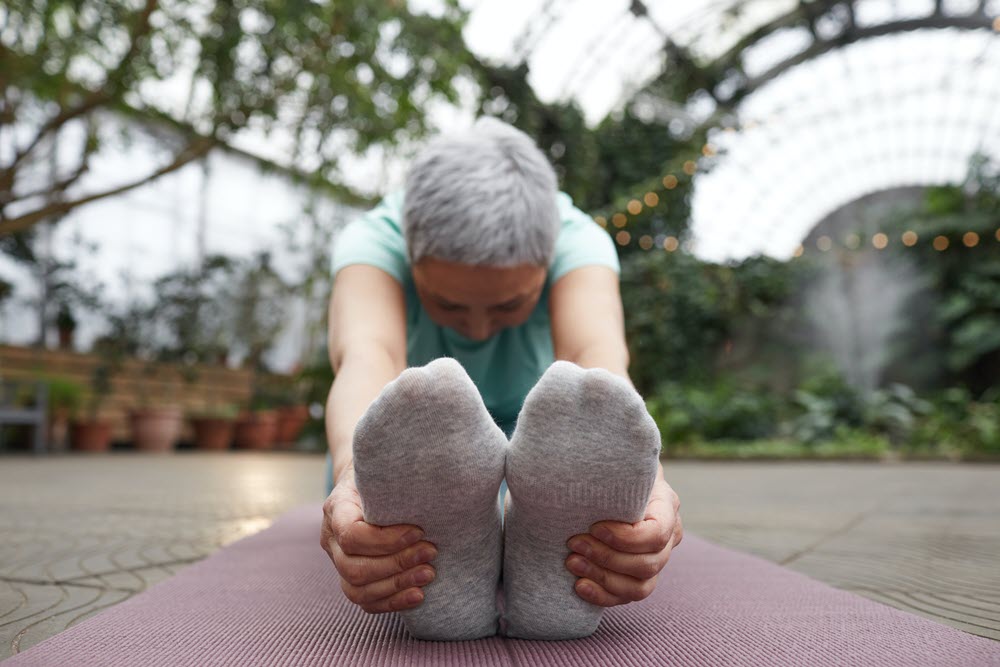
As we age, maintaining flexibility, balance, and overall mobility becomes increasingly important. Doing so is crucial for supporting our daily activities, reducing fall risk, and preventing injuries.
One effective way to achieve this is by incorporating stretching into our daily routine. In this article, we will explore the numerous health benefits of stretching for older adults and discuss some practical tips on how to get started.
Top Health Benefits for Stretching
Muscles, tendons, and ligaments naturally lose their elasticity and become stiffer as people age. This can result in a reduced range of motion, making it more difficult to perform everyday tasks like reaching for objects, bending down, or even walking.
Stretching is an essential component of any fitness program and it becomes even more crucial as we grow older. By regularly stretching, older adults can maintain their flexibility, reduce the risk of injury, and improve their quality of life.
Enhanced Flexibility and Range of Motion
Regular stretching can improve flexibility and increase the range of motion in your joints, making it easier to perform daily tasks and keep you active for much longer.
This is powerful for seniors, as flexibility and mobility tend to decrease with age. Such decreases can raise the risk of falls, which is fantastic, as falls can cause serious harm and even noticeably decrease independence.
The improvement in flexibility can make it easier to move. This can make your life easier to manage and increase your ability to exercise.
Reduced Pain and Stiffness
Stretching also helps to alleviate muscle tightness and stiffness, symptoms that can contribute to chronic pain in older adults. By keeping muscles and joints flexible, you can relieve pain and prevent future discomfort.
This is even true for people with chronic pain. While stretching might not remove all the pain you experience, it can make a noticeable difference.
Improved Posture
Poor posture is a common issue for older adults, often resulting from muscle imbalances and weak core strength. Stretching can help correct these imbalances, leading to improved posture and reduced strain on your spine.
Better Balance and Coordination
Maintaining good balance and coordination is crucial for older adults to prevent falls and related injuries. Stretching can improve your proprioception—the awareness of your body’s position in space—allowing you to move more confidently and safely.
Increased Circulation
Stretching promotes blood flow to your muscles, delivering essential nutrients and oxygen. This increased circulation can aid in faster recovery from injuries and help reduce muscle soreness.
Stress Relief
Stretching can help relieve stress and promote relaxation by releasing muscle tension and increasing the production of endorphins—the body’s natural feel-good hormones.
Improved Mood
As with regular exercise, stretching can help to improve your mood – partly because you’re decreasing your stress levels. The process also promotes calmness and relaxation, which is always a good thing.
Stretching also helps to get people into their bodies and out of all the negative stories in their heads. This is a surefire way to improve mood and promote better mental health.
Tips for Incorporating Stretching into Your Routine
To make stretching a regular part of your daily routine, consider the following tips:
Choose the Right Time
First, the time you choose to stretch will have a noticeable impact.
You’re looking for the time that works best for you. This will likely be the point in the day when you have the most energy and attention.
Some people find that the morning is the best time, as stretching helps them to wake up to their body. This is especially good if you often feel stiff when you wake up.
You might prefer to stretch in the evening instead, as a way to unwind before bed. Or, perhaps you might pick a time during the day. The time could also vary, based on what works best each day (particularly if your energy levels fluctuate).
Warm Up First
Warming up your muscles is essential for preventing injury. Just 5 to 10 minutes of light aerobic activity, like walking or marching in place is often all you need.
Start Slowly and Progress Gradually
Begin with gentle dynamic stretching and gradually increase the intensity as you become more comfortable. Hold each stretch for 15-30 seconds and aim for two to four repetitions per stretch.
When you first start stretching, you’ll probably want short sessions that aren’t too challenging. You can start to increase the amount of stretching and the difficulty as you go. Starting slowly gives your body time to adjust to your new stretching routine and decreases the risk of injury.
Focus on Major Muscle Groups
Target the major muscle groups, including your calves, thighs, hips, lower back, neck, and shoulders, as these areas tend to be the tightest and most prone to injury.
Listen to Your Body
Stretching should never be painful. If you feel pain, ease off the stretch and avoid overstretching, which can lead to injury. You should also be cautious about any exercises that simply don’t feel ‘right’.
Remember, no one knows your body better than you do. Some exercises might be perfectly fine for someone else and simply not suitable for you.
Important Precautions to Take
As you begin to incorporate stretching into your routine, keep these precautions in mind:
Consult Your Healthcare Provider
You should always consult your healthcare provider before starting any exercise or stretching regimen. This is especially true if you have any pre-existing conditions, noticeable pain, or are on medication.
Your healthcare provider will be able to tell you whether there’s anything to be concerned about. They may also suggest avoiding particular types of stretches or focusing mostly on specific areas of your body.
Consider Consulting an Expert
To get the benefits of stretching, you need to be following the right form and taking care of yourself. Doing so can be confusing at first, so you may want to talk to an expert.
A physical therapist is the most powerful professional here, as these trainers have training in the human body, movement, and physiology. They can show you the best exercises for your needs.
A personal trainer or physical therapist can help you find the right stretches for your needs and avoid any that might cause harm. They can also demonstrate the stretches, helping you to get the correct form.
Avoid Bouncing
Bouncing increases the stress on your muscles, which then increases the risk of injury. Doing so is also less relaxing than regular stretching, so you’re not even getting the regular benefits from stretching.
It’s much better to focus on static stretching instead, where you’re holding the stretch for perhaps 15 or 30 seconds at a time. This will give you the most benefits and has many fewer risks.
Be Regular
You won’t see many benefits if you just stretch every so often. It’s much better to be consistent with stretching. Try to stretch at least a few times per week, if not every day.
Final Thoughts
Stretching is fantastic for seniors, helping with flexibility, mobility, and more. It’s especially powerful for those who find exercise difficult.
That said, stretching is just one aspect of a healthy lifestyle. It’s still important to exercise, to spend time outdoors, and to eat well. These practices all contribute to better health and longer life.
Feeling Overwhelmed?
Check out our Caregiving Consulting service for personalized support and guidance.

Well, I was in misconnect about stretching, as stretching is an important practice for older adults to maintain flexibility, balance and overall mobility. As we age, our muscles, tendons and ligaments naturally become stiffer for resulting in a reduced range of motion.